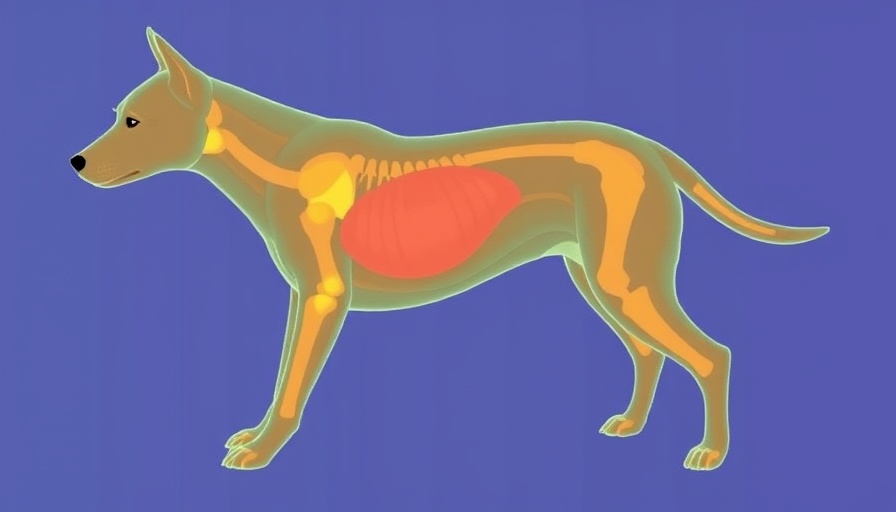
Understanding Stage 3 IVDD: A Critical Condition for Canine Health
Intervertebral Disc Disease (IVDD) can be a heart-wrenching diagnosis for dog owners, especially when their cherished companions reach Stage 3. This stage signifies a serious shift in the dog's health, where they face significant nerve damage and loss of mobility. With the right information and support, veterinarians, pet nutritionists, trainers, and advocates can make informed decisions to help these patients recover.
What Causes Stage 3 IVDD in Dogs?
Stage 3 IVDD typically occurs when the cushioning discs between the vertebrae slip or rupture. The resulting pressure on the spinal cord can lead to severe pain and neurological issues. Commonly, dogs in this stage are unable to walk properly, with symptoms that can arise suddenly. This drastic change emphasizes the need for immediate veterinary attention.
Recognizing the Signs: Symptoms of Stage 3 IVDD
Pet parents and professionals must be vigilant in recognizing the signs of Stage 3 IVDD. The primary indicators include:
- Difficulty standing or walking
- Wobbly or dragging back legs
- Loss of coordination and muscle weakness
- Signs of pain, such as yelping or reluctance to move
This stage presents a unique challenge as symptoms can develop rapidly, often leaving pet owners at a loss for what to do next.
Diagnosing Stage 3 IVDD: How Veterinarians Can Help
Veterinarians play a crucial role in diagnosing Stage 3 IVDD. The process often begins with a thorough physical and neurological examination of the dog. Veterinarians check reflexes, assess limb movement, and evaluate pain response through techniques like toe pinching. While X-rays are common, advanced imaging techniques like MRI or CT scans offer a clearer view of the spinal cord and surrounding tissues, aiding in accurate diagnosis.
Treatment Options: Navigating Care for Affected Dogs
Once a dog is diagnosed with Stage 3 IVDD, treatment options vary based on the severity of the condition. Most notably, treatments fall into two categories: surgical and nonsurgical.
Nonsurgical Treatments:
For many dogs, nonsurgical management can be effective, particularly when they still retain deep pain perception. Recommended therapies may include:
- Crate rest for minimal movement, usually lasting 4 to 6 weeks
- Anti-inflammatory medications to reduce swelling
- Pain management with specific medications
- Controlled short walks for bathroom necessities
With dedication and consistency, many dogs begin to recover, gaining back strength and coordination.
Surgical Considerations:
In cases where nonsurgical treatments fail, or if neurological functions worsen, surgery may become necessary. Surgical procedures can offer the potential to relieve pressure on the spinal cord, although they involve their own risks and recovery considerations. Collaborating with a veterinary specialist can ensure that the best decisions are made regarding surgery.
Recovery Process: What to Expect During Rehabilitation
The recovery process after treatment for Stage 3 IVDD varies by individual dog. Post-treatment rehabilitation can be crucial for their return to mobility. Factors that influence recovery include:
- The degree of nerve damage sustained
- The timeliness of treatment
- Consistency in following rehabilitation protocols
Caring for dogs recovering from IVDD may involve physical therapy, continued medication, and modifications to their environment to prevent further injury. Support organizations and pet grief counselors can also help pet owners navigate the emotional aspects of caring for a dog with IVDD.
Future Outlook: What Lies Ahead for Dogs with Stage 3 IVDD
While Stage 3 IVDD presents significant challenges, many dogs can still achieve impressive recoveries. Positive outcomes often hinge on prompt veterinary intervention and a dedicated rehabilitation plan. With the support of pet owners, veterinarians, trainers, and advocates, canines with IVDD can often return to a fulfilling life, filled with play and companionship.
Concluding Thoughts: Empowering Pet Owners
Understanding Stage 3 IVDD equips caring pet parents and veterinary professionals with the knowledge needed to advocate for their four-legged friends. The effects of IVDD can be daunting, but with timely diagnosis, effective treatments, and robust recovery support, many dogs can resume their happy and active lives. Every step taken towards recovery counts, so if you notice the warning signs in your dog, reaching out to your veterinarian immediately is vital.
 Add Row
Add Row  Add
Add 




Write A Comment